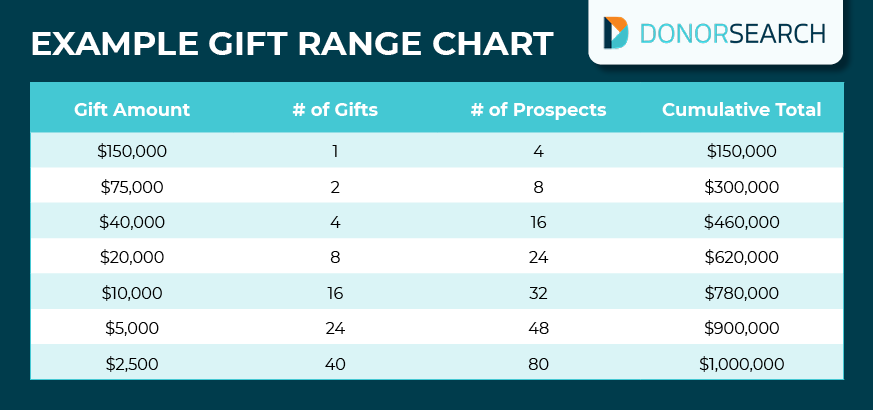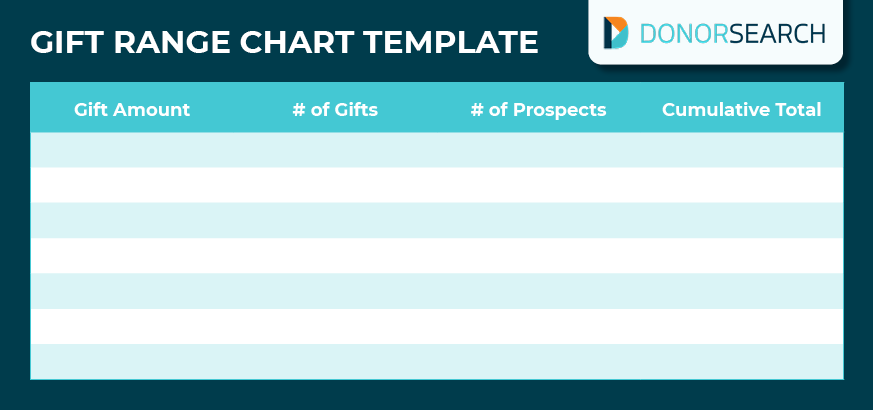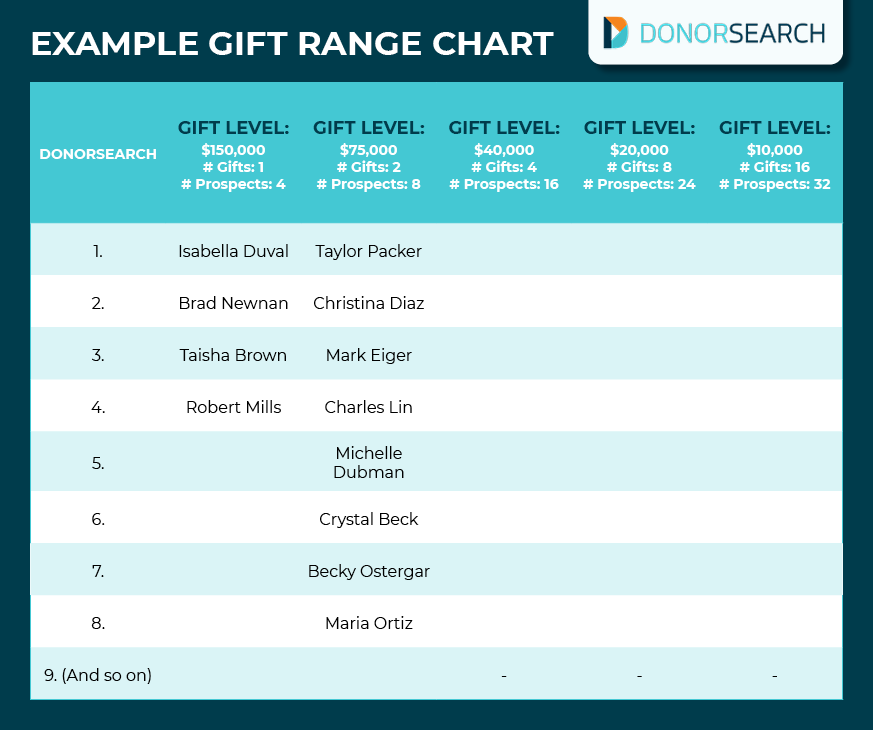
Building a Gift Range Chart: A Quick Guide & Template
Fundraising. It’s what your nonprofit depends on to do everything from keeping the lights on to delivering services to beneficiaries in need. But it’s often the most challenging part of running a mission-driven organization.
This is why it’s critical to have a comprehensive, data-driven fundraising strategy in place. An effective strategy empowers your team to extend the right fundraising asks at the right time to reach potential donors who can help you achieve your goals and drive more impact.
One of the most useful resources you can have in your fundraising toolbox is a gift range chart. These charts, put together with your donor data and goals in mind, show you how many gifts you need to secure at certain levels in order to achieve success.
In this post, we’ll explore how you can build a gift range chart and get the most mileage out of it as possible. Specifically, we’ll cover:
–Nonprofit Gift Range Charts: An Overview
–DonorSearch’s Gift Range Chart Template (& How to Use It)
A well-thought-out gift range chart can make all the difference in how you think about your donor base and how you approach fundraising asks. If you’re ready to take a more deliberate, intentional approach to fundraising, it’s time to make a chart of your own! Let’s dive right in.


Nonprofit Gift Range Charts: An Overview
To create an effective gift range chart for your own nonprofit, you first need to understand the purpose of a gift range chart and how it can help boost your strategy. Let’s look at a few commonly asked questions.
What is a gift range chart?
Gift range charts, also known as gift pyramids, provide a visual representation of how many gifts you need to secure of specific sizes in order to meet the goal of your fundraising campaign. In a way, they make fundraising campaigns seem more feasible, as they illustrate how the total you need can be pulled in from many different donors.
These charts take a pyramid-like, top-down approach, with the largest gifts listed at the top along with the number of prospects that could give those gifts, followed by lower-level gifts and the number of prospects you have at each of those levels. The number of prospects for each level will increase as you move down the tiers of the chart, since only a few donors will be able to give the largest gifts, but many donors will be able to give mid-sized and small gifts.
Here’s an example of a fully filled-out gift range chart:

For this campaign, the total needed from individual donations is $1 million. Thus, the chart shows that this organization will need to secure one gift of $150,000 and that the organization has four prospects it can seek this gift from. The second tier shows something similar—the organization needs two gifts of $75,000 and has eight prospects it can ask, and so on, with the size of gift decreasing and the number of prospects that could give that size of gift increasing as you move down the chart.
When should I use a gift range chart?
Gift pyramids are commonly used in large-scale capital campaigns but can be useful tools for campaigns and organizations of any size. They’re simply resources that break up campaign goals into realistic chunks and show you the kinds of donors you need to connect with and cultivate.
What are the benefits of building a gift range chart?
Without question, gift range charts should be a part of your fundraising strategy arsenal. Despite their deceptively simple design, gift range charts can tell you a lot about your fundraising strategy, especially if your nonprofit is looking to embark on a capital campaign.
Specifically, gift range charts can show you:
- The initial donor outreach work you’ll need to conduct in order to meet your goal. When you start something like a capital campaign, you can create a gift range chart that shows you the gaps in your fundraising strategy where you need to find new prospects (especially for large-scale campaigns, which won’t rely solely on existing donors). If there are massive gaps in your chart, that is a sign you may need to adjust your goal.
- What giving levels to suggest to donors. It isn’t likely that your donors will magically know what your fundraising goals are unless you give them a target to follow. Additionally, you don’t want to approach prospects with too ambitious of an ask or risk leaving money on the table. Figure out what kind of asks to present to donors so you can reach your goal more efficiently.
- What kind of and how many prospects to target at each level. Similarly, you’ll need to target the right number of donors at each level. Not everyone can give major gifts, so you need to identify how many prospects to reach out to at every level of giving.
- How to prioritize your resources. Once you know how many prospects you need to target, and how much to expect from these prospects, you can prioritize resources during the donor outreach process. There are fewer individuals out there who can give very generously, so prioritize major gifts first and invest your resources in securing them before moving on to smaller gifts.
- How to build out your fundraising strategy. Your fundraising strategy should be intrinsically built upon what you discover when creating your gift range chart. With your chart, you’ll get a better idea of how many donors you need to acquire or retain over your campaign, what types of gifts to ask for, etc.
- How you’ll track and report on campaign progress. A gift range chart is a framework for taking a logical, strategic approach to securing gifts. It can help everyone, from your board to your gift officers, see what it will take to achieve your fundraising goal, and can keep your whole team on track as you move your campaign forward.
The bottom line: Your gift range chart doesn’t simply lay out the fundraising benchmarks your nonprofit needs to meet to achieve your goals. Completing a gift range chart can help you better understand what it will take to achieve your fundraising goals, as well as assess your fundraising strategy and lay out the steps you should take to be successful with it.
How do you create a gift chart?
When you create your first gift range chart, it may be useful to use a gift range calculator tool or a template (see ours below!) to get yourself started, as well as robust fundraising software. Note that you’ll need to tinker with a template or calculator-generated chart to make sure the final product is going to be useful for your campaign.
We’ll dive into the specifics of creating a gift chart below!

DonorSearch’s Gift Range Chart Template (& How to Use It To Build Your Own)
Don’t be fooled; using a gift range chart isn’t as simple as collecting $50,000 donations from 20 major gift prospects to meet a campaign goal of $1 million.
Quite the contrary! Gift range charts are structured like pyramids (remember, they’re sometimes called gift pyramids). They allow you to break down a fundraising goal by identifying:
- How many major gifts you should pursue from a handful of donors
- How many mid-sized gifts you should seek from a moderate number of donors
- How many smaller gifts you should solicit from the largest segment of your donors
- The cumulative total of each gift range
Here is our template for a gift range chart, representing each of these elements:

Note that the breakdown of your specific gift range chart will likely look different based on a number of factors, like the size of your organization or your fundraising goal. Here are a few steps for how to fill out our gift pyramid template and make it your own:
- Start with your lead gift (your largest gift), which will be somewhere in the ballpark of 15-25% of your total campaign goal.
- Move down the pyramid, increasing the number of gifts as the donation amount goes down.
- Tinker with the number of prospects you need for each gift amount—you should have three to four qualified prospects for every gift you need to achieve your goal.
Be mindful that gift range charts change with campaign type. For example, when planning capital campaigns with larger, one-time fundraising goals, you’ll aim to reach more high-level donors. When designing a gift range chart for an annual campaign, factor in more low-to-mid-range donors. When getting ready for a crowdfunding campaign, count on many small donations to make up the bulk of your fundraising.

Using Your Gift Range Chart
It’s one thing to create a gift range chart, but it’s another thing to actually put it to good use. After all, for it to effectively shape how you fundraise, you need to use it as a guiding document for your entire campaign. Consider the following tips to get the most out of your gift range chart:
- Create a depth chart using prospect research findings. A depth chart takes the information in your gift range chart one step further. It simply allows you to list each gift size in a column and begin identifying prospects you’ll ask for that gift by name. Here’s an example of what a depth range chart might look like:

- Build your campaign timeline around your chart. A gift range chart can give you an idea of how much time it will take to meet your campaign goal. By creating it early on in the planning stage of your campaign, you can build the rest of your fundraising activities around it, coming up with a realistic timeline that will allow you to meet that goal and avoid stress and scrambling in the final hours of the campaign.
- Be efficient with your time by pursuing the largest gifts first. Securing a major gift can take a long time. By visually identifying how many major gifts you need to solicit and from whom, you can take a more efficient approach to donor outreach and making fundraising asks.
- Return to your chart often to monitor your progress. Throughout your campaign, you should turn back to your gift range chart. Compare the gifts you’ve secured to the gifts you planned to secure to know how much further you need to go to meet your goal.
- Build a donor recognition strategy off of your gift range chart. Since your gift range chart can help you visualize how many gifts you’ll need of specific sizes, you can start to plan out your donor recognition strategy using your chart. For example, if you’ll need to solicit seven major gifts, you can make plans to publicly recognize your seven major donors well ahead of time. If you know you’ll be looking for 250 gifts of $100, you can plan a strategy for writing personalized thank-you notes to those donors toward the end of the campaign.
Your gift range chart can serve as a foundational resource for your fundraising campaign, one that helps you plan out your campaign and stay anchored to your central goal. Let it guide you through the fundraising process, and you’ll experience success!

Final Thoughts
Fundraising doesn’t need to be a guessing game. In fact, it shouldn’t be—pursuing gifts in a willy-nilly fashion won’t get you very far. With a gift range chart, you can take a deliberate, intentional approach to soliciting donations and consistently move toward your fundraising goals.
Use this guide to start building your own gift range chart and to make good use of it! You’ve got this.
Looking to learn more about the world of fundraising? Here are some resources we recommend:
- Creating Your Nonprofit Annual Report: Full Guide & Template. Your annual report is a showcase of all of your nonprofit’s accomplishments over a year and can be a great tool for marketing your mission. Learn more in this article.
- Nonprofit Fundraising Metrics: 32 KPIs To Measure Success. Fundraising metrics can show you where your nonprofit is succeeding and where it could improve. Check out this guide to learn about the metrics you should be tracking (and how to calculate them).
- Major Gifts: A Guide to Securing Large Donations. Pulling in major gifts is no small feat. Learn how to build lasting relationships with donors and make fundraising asks at the right time using this resource.

